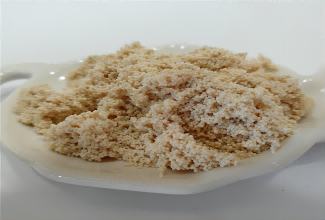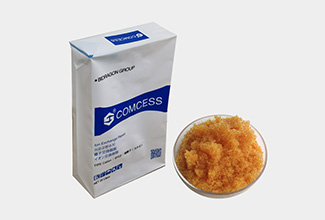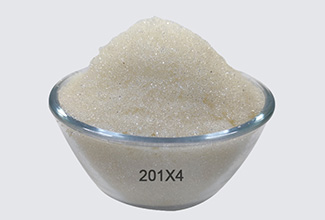Succinic Acid Purification Ion Exchange Method
Succinic acid is a four-carbon dicarboxylic acid widely used in food, pharmaceutical and chemical industries. In industrial production, in order to obtain high purity succinic acid, its purification is usually required. Ion exchange is one of the commonly used purification methods, which is particularly suitable for separating and purifying succinic acid from fermentation broth or other solutions containing impurities.
Basic principle of ion exchange method
Ion exchange is based on the principle that ion exchange resins undergo a reversible exchange reaction with ions in solution. For the purification of succinic acid, cation exchange resins are usually used because succinic acid can dissociate H+ ions, which can be exchanged with fixed charge groups on the cation exchange resin.
1. Principle analysis
Properties of succinic acid: Succinic acid (C₄H₆O₄) is a dicarboxylic acid that dissociates in two steps in water:
- pKa₁ ≈ 4.2 (-COOH → -COO⁻ + H⁺)
- pKa₂ ≈ 5.6 (-COO⁻ → -COO⁻² + H⁺)
Resin selection: Strongly basic anion exchange resin (such as polystyrene quaternary ammonium salt type, Cl⁻ type or OH⁻ type), because it has strong adsorption capacity for doubly charged anions at high pH.
2. Operation steps
(1) Resin pretreatment
Activation: Soak the resin in 4% NaOH solution for 2 hours to convert it to OH⁻ type; wash with water until neutral.
Column packing: wet packing of resin column (avoid bubbles), the recommended column height-to-diameter ratio is 5:1~10:1.
(2) Pretreatment of feed solution
pH adjustment: adjust the crude succinic acid solution to pH 6~7 with NaOH to ensure that C₄H₄O₄²⁻ is the main form.
Filtration: remove suspended matter (0.45 μm filter membrane) to prevent clogging of the resin.
(3) Adsorption process
Sample flow rate: control the flow rate to 1~2 BV/h (bed volume/hour), and dynamically adsorb until the resin is saturated (the breakthrough point can be monitored by conductivity).
Adsorption capacity: refer to the resin exchange capacity (such as Dowex 1×4 about 1.2 eq/L) to calculate the maximum sample load.
(4) Elution of impurities
Rinse with deionized water at 2 BV/h to remove unadsorbed neutral impurities and salts.
(5) Elution of target
Eluent selection:
Acidic elution: 0.5~1 M HCl (pH < 2), protonate succinic acid into neutral molecules (C₄H₆O₄), and detach from the resin.
Salt solution elution: 1~2 M NaCl + dilute acid (pH 3~4), through Cl⁻ competitive exchange.
Elution flow rate: 1 BV/h, collect eluent in segments, and detect succinic acid peak by HPLC or TLC.
(6) Post-treatment
Concentration and crystallization: Rotary evaporation to concentrate to supersaturation, cool to 4℃ for crystallization, and collect crystals by centrifugation.
Desalting: If the eluent contains salt, electrodialysis or secondary ion exchange can be used for desalting.
(7) Resin regeneration
Regeneration agent: 4% NaOH solution, 2~3 BV, flow rate 0.5 BV/h, convert back to OH⁻ type.
Preservation: Long-term storage needs to be converted to Cl⁻ type (treated with NaCl) to prevent microbial growth.
3. Common problems and solutions
Low adsorption efficiency:
- Check whether the pH is too low or the resin is not fully regenerated.
- Use a high cross-linking resin (such as COMCESS CS-2×8) to enhance the adsorption of doubly charged ions.
- Elution peak tailing:
- Gradient elution: gradually increase the eluent concentration (such as 0.1 M → 0.5 M HCl).
- Add organic solvents (such as 10% ethanol) to reduce hydrophobic interactions.
- Resin contamination:
- Pretreatment of feed liquid: activated carbon decolorization, ultrafiltration to remove macromolecules.
- Regularly clean the resin with a mixture of 0.1 M NaOH + 10% NaCl.
4. Application scenario expansion
Industrial purification: multiple columns in series to achieve continuous production, combined with electrodialysis desalination to reduce costs.
Purification of biological fermentation broth: first remove protein (isoelectric precipitation) and pigment (activated carbon adsorption), then ion exchange.
Through the above steps, the ion exchange method can effectively purify succinic acid to a purity of more than 99%, which is suitable for laboratory and industrial production. In actual operation, the process parameters need to be adjusted according to the impurity characteristics of the raw materials.
Basic principle of ion exchange method
Ion exchange is based on the principle that ion exchange resins undergo a reversible exchange reaction with ions in solution. For the purification of succinic acid, cation exchange resins are usually used because succinic acid can dissociate H+ ions, which can be exchanged with fixed charge groups on the cation exchange resin.
1. Principle analysis
Properties of succinic acid: Succinic acid (C₄H₆O₄) is a dicarboxylic acid that dissociates in two steps in water:
- pKa₁ ≈ 4.2 (-COOH → -COO⁻ + H⁺)
- pKa₂ ≈ 5.6 (-COO⁻ → -COO⁻² + H⁺)
Resin selection: Strongly basic anion exchange resin (such as polystyrene quaternary ammonium salt type, Cl⁻ type or OH⁻ type), because it has strong adsorption capacity for doubly charged anions at high pH.
2. Operation steps
(1) Resin pretreatment
Activation: Soak the resin in 4% NaOH solution for 2 hours to convert it to OH⁻ type; wash with water until neutral.
Column packing: wet packing of resin column (avoid bubbles), the recommended column height-to-diameter ratio is 5:1~10:1.
(2) Pretreatment of feed solution
pH adjustment: adjust the crude succinic acid solution to pH 6~7 with NaOH to ensure that C₄H₄O₄²⁻ is the main form.
Filtration: remove suspended matter (0.45 μm filter membrane) to prevent clogging of the resin.
(3) Adsorption process
Sample flow rate: control the flow rate to 1~2 BV/h (bed volume/hour), and dynamically adsorb until the resin is saturated (the breakthrough point can be monitored by conductivity).
Adsorption capacity: refer to the resin exchange capacity (such as Dowex 1×4 about 1.2 eq/L) to calculate the maximum sample load.
(4) Elution of impurities
Rinse with deionized water at 2 BV/h to remove unadsorbed neutral impurities and salts.
(5) Elution of target
Eluent selection:
Acidic elution: 0.5~1 M HCl (pH < 2), protonate succinic acid into neutral molecules (C₄H₆O₄), and detach from the resin.
Salt solution elution: 1~2 M NaCl + dilute acid (pH 3~4), through Cl⁻ competitive exchange.
Elution flow rate: 1 BV/h, collect eluent in segments, and detect succinic acid peak by HPLC or TLC.
(6) Post-treatment
Concentration and crystallization: Rotary evaporation to concentrate to supersaturation, cool to 4℃ for crystallization, and collect crystals by centrifugation.
Desalting: If the eluent contains salt, electrodialysis or secondary ion exchange can be used for desalting.
(7) Resin regeneration
Regeneration agent: 4% NaOH solution, 2~3 BV, flow rate 0.5 BV/h, convert back to OH⁻ type.
Preservation: Long-term storage needs to be converted to Cl⁻ type (treated with NaCl) to prevent microbial growth.
3. Common problems and solutions
Low adsorption efficiency:
- Check whether the pH is too low or the resin is not fully regenerated.
- Use a high cross-linking resin (such as COMCESS CS-2×8) to enhance the adsorption of doubly charged ions.
- Elution peak tailing:
- Gradient elution: gradually increase the eluent concentration (such as 0.1 M → 0.5 M HCl).
- Add organic solvents (such as 10% ethanol) to reduce hydrophobic interactions.
- Resin contamination:
- Pretreatment of feed liquid: activated carbon decolorization, ultrafiltration to remove macromolecules.
- Regularly clean the resin with a mixture of 0.1 M NaOH + 10% NaCl.
4. Application scenario expansion
Industrial purification: multiple columns in series to achieve continuous production, combined with electrodialysis desalination to reduce costs.
Purification of biological fermentation broth: first remove protein (isoelectric precipitation) and pigment (activated carbon adsorption), then ion exchange.
Through the above steps, the ion exchange method can effectively purify succinic acid to a purity of more than 99%, which is suitable for laboratory and industrial production. In actual operation, the process parameters need to be adjusted according to the impurity characteristics of the raw materials.
Related Products
-
 Copper Removal ResinPurity:99.9%Appearance:Milky to light yellow opacity spherical beadsMoisture content (%):48.00-60.00
Copper Removal ResinPurity:99.9%Appearance:Milky to light yellow opacity spherical beadsMoisture content (%):48.00-60.00 -
 C008FG Food Grade ion exchange resinAppearance: Claybank to tan transparent spherical particle.The degree of crosslinking : 8%.Ionic form:Na+
C008FG Food Grade ion exchange resinAppearance: Claybank to tan transparent spherical particle.The degree of crosslinking : 8%.Ionic form:Na+ -
 201×4 Food Grade anion Exchange Resin for sugar decolorationAppearance: Light yellow to gold yellow transparency sphericity particles.The degree of crosslinking : 4%.Ionic form:Cl-
201×4 Food Grade anion Exchange Resin for sugar decolorationAppearance: Light yellow to gold yellow transparency sphericity particles.The degree of crosslinking : 4%.Ionic form:Cl-
Message

